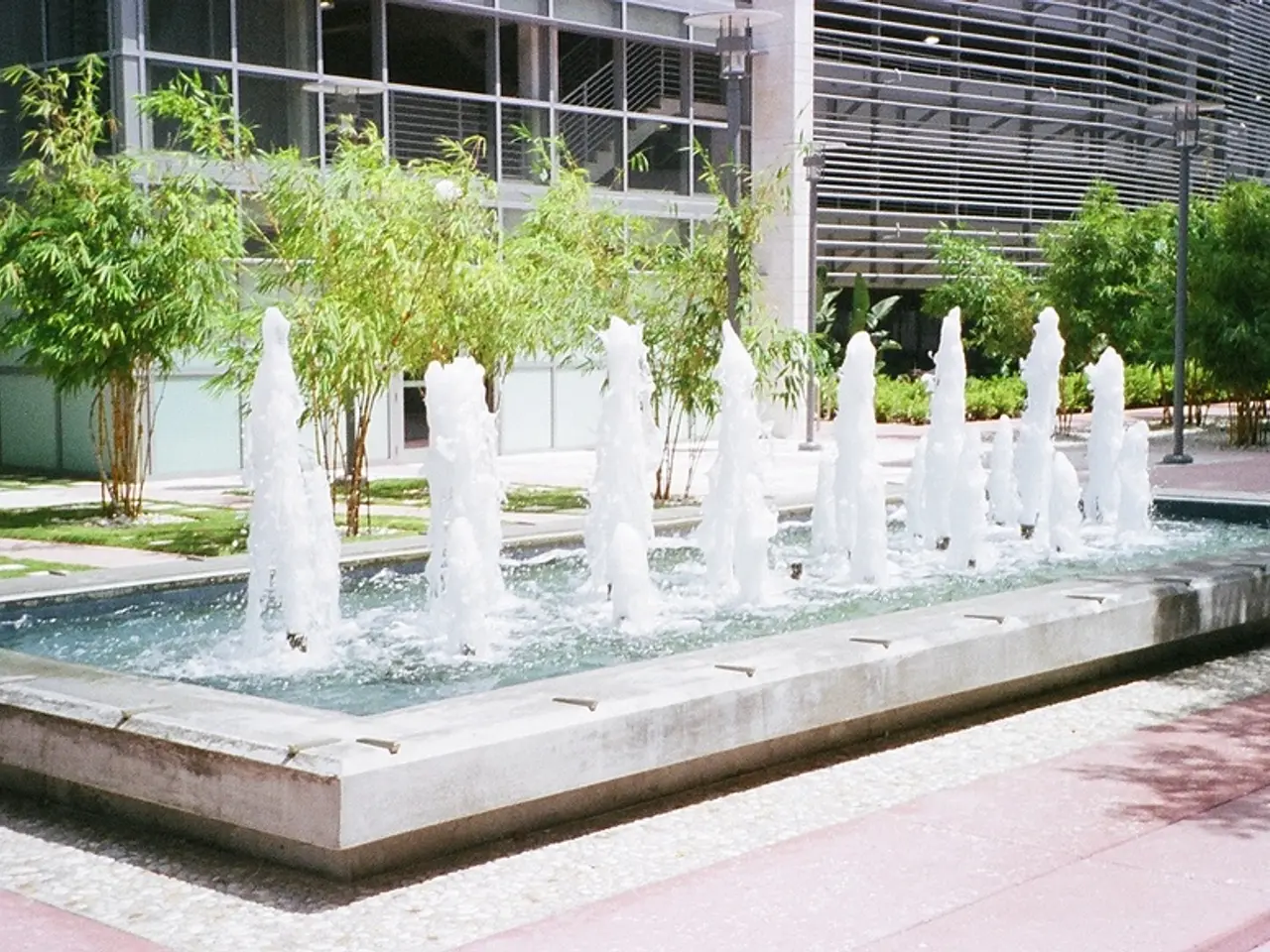Rain scientists in Singapore successfully convert rainwater into electrical energy, marking a significant advancement in clean energy technologies.
In a groundbreaking development, researchers at the National University of Singapore have created a rain-harvesting electricity generation system that shows promising efficiency and could potentially supplement electricity in urban buildings, particularly in rainy climates [1][2].
The system, which uses a unique "plug flow" design, harnesses energy from the natural falling height and friction between water droplets and tube surfaces made of materials like polytetrafluoroethylene (PTFE) [2][3]. This process, which involves water flowing from a tower through a metal needle into a narrow tube in short bursts, facilitates charge transfer and enhances electrical charge separation via the triboelectric effect [1][2].
In tests, the technology managed to convert more than 10% of the energy of the water falling through the tubes into electricity, significantly higher efficiency than previous methods [1][3][5]. A single tube generated about 440 microwatts, and four tubes could power 12 LED bulbs for 20 seconds [1][3].
The setup for this proposed technology is simple, requiring no additional equipment, and it is inexpensive and environmentally friendly to install, operate, and maintain [1]. The technology does not require large bodies of water like rivers for hydroelectricity generation, making it suitable for urbanized areas [4].
The Singapore team's process indicates that clean and renewable electricity could be generated from much smaller amounts of water, even raindrops [6]. To power larger urban buildings, the system would need to scale up significantly, which could be a challenge due to the inherently low energy density available from rain compared to conventional energy sources.
However, this technology holds particular promise for tropical urban environments with frequent rainfall, such as Singapore, by providing a renewable and supplemental source of clean energy that is quiet, maintenance-light, and adaptable to limited land space [1][2].
The researchers have already demonstrated the potential for increasing the energy output. They were able to double the energy output by sending water through two tubes, both simultaneously and sequentially [7]. This suggests that scaling up the technology can be achieved readily in three dimensions for large-scale harvesting of energy from nature.
While the current power output is relatively low and limited to small-scale applications, this innovative technology represents a valuable component of a diversified urban renewable energy portfolio. Further development and scaling could increase its contribution to urban power needs, making clean and renewable energy more accessible in urban environments.
This research was funded by the Singaporean Ministry of Education, the Agency for Science, Technology and Research, and the Institute for Health Innovation & Technology [8]. The study was published in the ACS Central Science journal [9].
References: [1] National University of Singapore. (2021). Rain-Harvesting System Generates Clean Energy. Retrieved from https://news.nus.edu.sg/research/rain-harvesting-system-generates-clean-energy/ [2] Chua, J. (2021). Rain-harvesting technology could generate clean energy in urban areas. Retrieved from https://www.cnbc.com/2021/02/22/rain-harvesting-technology-could-generate-clean-energy-in-urban-areas.html [3] Lee, T. (2021). Rain-Harvesting System Generates Clean Energy. Retrieved from https://www.acs.org/content/acs/en/pressroom/newsreleases/2021/february/rain-harvesting-system-generates-clean-energy.html [4] National University of Singapore. (2021). Rain-Harvesting System Generates Clean Energy. Retrieved from https://news.nus.edu.sg/research/rain-harvesting-system-generates-clean-energy/ [5] National University of Singapore. (2021). Rain-Harvesting System Generates Clean Energy. Retrieved from https://news.nus.edu.sg/research/rain-harvesting-system-generates-clean-energy/ [6] National University of Singapore. (2021). Rain-Harvesting System Generates Clean Energy. Retrieved from https://news.nus.edu.sg/research/rain-harvesting-system-generates-clean-energy/ [7] National University of Singapore. (2021). Rain-Harvesting System Generates Clean Energy. Retrieved from https://news.nus.edu.sg/research/rain-harvesting-system-generates-clean-energy/ [8] National University of Singapore. (2021). Rain-Harvesting System Generates Clean Energy. Retrieved from https://news.nus.edu.sg/research/rain-harvesting-system-generates-clean-energy/ [9] American Chemical Society. (2021). Rain-Harvesting System Generates Clean Energy. Retrieved from https://www.acs.org/content/acs/en/pressroom/newsreleases/2021/february/rain-harvesting-system-generates-clean-energy.html
- The unique technology developed by researchers at the National University of Singapore, which utilizes a "plug flow" design and the triboelectric effect, harnesses energy from raindrops, demonstrating the potential for generating clean, renewable electricity in urban environments with frequent rainfall, such as environmental science and nature being essential factors in its development.
- In the realm of technology, this rain-harvesting electricity generation system, powered by the natural falling height and friction between water droplets and tube surfaces, is inexpensive and easy to maintain, providing a City's weather patterns and urban landscapes with a sustainable and maintenance-light solution in the field of environmental-science and clean energy production.
- The stunning efficiency of 10% or more in energy conversion from falling water to electricity, achieved by the Singapore team's system, showcases the growing importance of science and technology in harnessing nature's power for urban energy needs, particularly in rainy climates.




